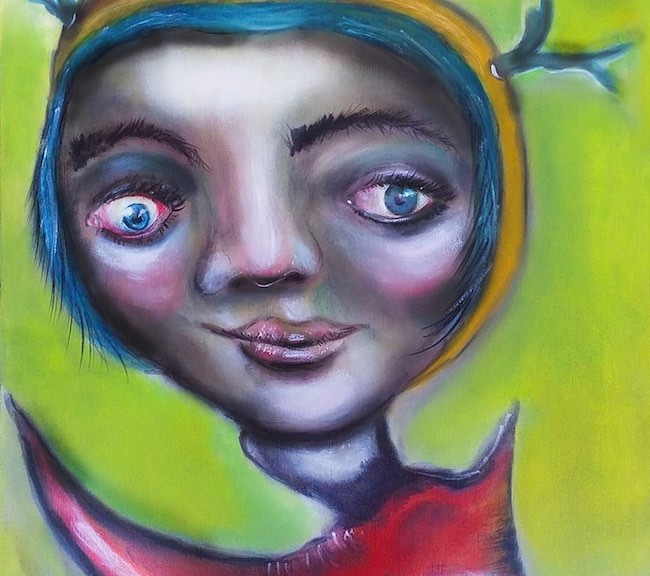Il tema dell’espressione del proprio essere, della propria interiorità o approccio all’esistenza è qualcosa su cui molti artisti contemporanei si confrontano spesso, tendendo a lasciar fuoriuscire tutto quel mondo emozionale che al di fuori della tela o della materia scultorea non sarebbero in grado di manifestare; questo perché la superficie grezza appare come una finestra di dialogo con se stessi, un modo per esplorare quelle sensazioni intime che solo nell’atto creativo trovano la loro voce. Lo stile espressivo diviene dunque semplicemente un mezzo affine alla personalità dell’esecutore dell’opera, a volte più impulsivo, altre più razionale, altre ancora più intimista. Nel caso della protagonista di oggi invece, l’approccio pittorico è lo strumento per narrare quella stranezza appartenente a ciascun individuo ma che difficilmente l’essere umano è in grado di accettare e di ammettere, persino con se stesso.
La scoperta della necessità di liberare tutto quel mondo interiore fino a poco prima lasciato in secondo piano rispetto alla perfezione e all’equilibrio estetico, sopraggiunse nel mondo dell’arte di fine Ottocento in maniera forte, quasi prepotente nella sua impellenza, come se le dighe delle regole accademiche non riuscissero più a frenare il desiderio di rompere gli argini espressivi; le teorie dei Fauves, che non costituirono mai un vero e proprio movimento pittorico se non un’unione per perseguire l’obiettivo comune di gettare le basi per un modo inedito di fare arte, sovvertirono ogni regola, destabilizzarono tutto ciò che era acquisito in termini di schemi esecutivi di un’opera d’arte. Chiaroscuro, prospettiva, attinenza alla realtà osservata, colori realistici, tutto era cancellato dall’unico imperativo di mostrare in maniera immediata e irruenta le pulsioni interiori, di interpretare tutto ciò che veniva colto dallo sguardo in maniera soggettiva e in quel modo portarlo sulla tela. La successiva evoluzione determinata dall’Espressionismo, che in base all’artista o al paese di provenienza assunse caratteristiche differenti soprattutto dal punto di vista descrittivo e della gamma cromatica, mise in evidenza un’altra caratteristica funzionale allo scopo imprescindibile del movimento, quella di abbandonare il legame con il bello, con l’armonia delle forme, se non affine alle sensazioni che si volevano imprimere sulla tela; le deformazioni grottesche di James Ensor e Oskar Kokoschka, i cui personaggi erano allegorie della superficialità o della dissoluzione dei valori della loro epoca, le atmosfere cupe e angosciose di Edvard Munch, l’ossessione per la nudità intesa come unico modo per sopravvivere alle atrocità della guerra e per sottolineare un attaccamento alla vita di Egon Schiele, erano in sostanza approcci differenti per esprimere le proprie emozioni, certo, ma in fondo anche per esplorare il mondo circostante, che non doveva essere bello per suscitare emozioni. Il tema della mancanza di equilibrio estetico funzionale a conoscere e accogliere i timori, le paure, le fragilità interiori fu ripreso anni dopo da uno dei maggiori rappresentanti della Scuola di Londra, Lucian Freud, che svelò al mondo la bellezza nell’imperfezione, il fascino dell’insicurezza di chi non corrisponde ai canoni di armonia esteriore tradizionali ma che, forse proprio per quello, è in grado di curare e approfondire altri aspetti.
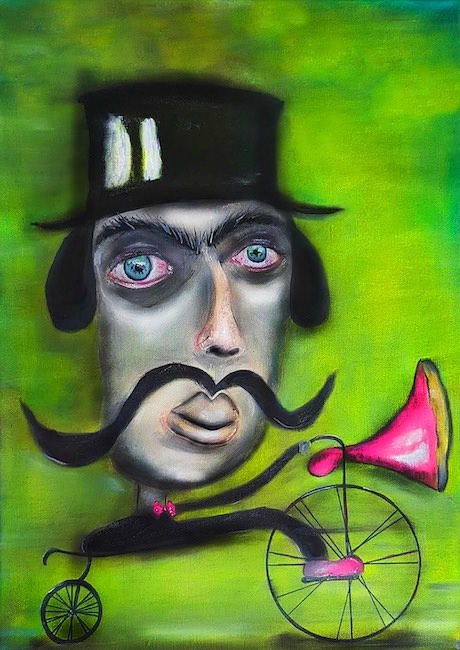
L’artista di origini rumene ma naturalizzata tedesca Ditha de Rablo percorre una strada in cui l’accettazione e la consapevolezza della diversità, della bizzarria, sono elementi fondamentali e imprescindibili per il suo personale stile pittorico definibile con il termine Gagaismo proprio perché i personaggi da lei descritti sono fuori dagli schemi, non temono il giudizio, non hanno paura di mostrarsi nella loro stranezza perché l’hanno accolta come parte di sé, come un’essenza di cui essere fieri. Il percorso di vita della de Rablo l’ha condotta a combattere per affermare la propria personalità non conforme a ciò che l’ambiente in cui era cresciuta avrebbe richiesto, e a seguito della scelta di perseguire la propria libertà ha dovuto affrontare ostacoli e difficoltà, cadute da cui poi si è rialzata con la consapevolezza che ciascun evento porti con sé un lato positivo purché le persone siano capaci di restare fedeli a se stesse, alla propria vera natura.
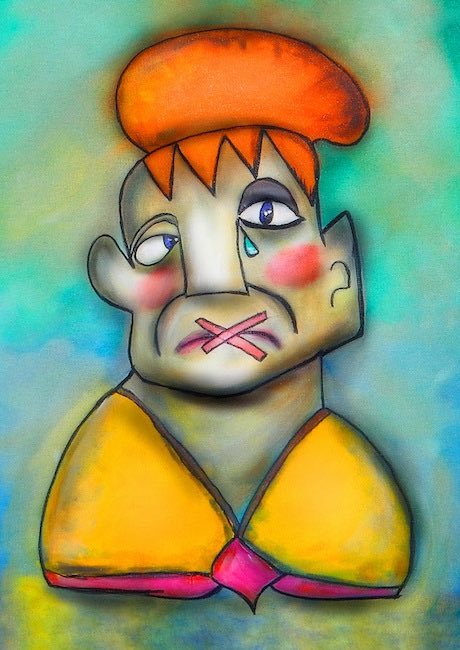
Dunque il suo percorso pittorico è stato un modo per sottolineare costantemente il suo orgoglio di appartenere a quel popolo di bizzarri, di fuori dal coro, di eccentrici denominati Gaga rappresentati per lungo tempo dalla celeberrima cantante Lady Gaga, che non hanno il timore di rivelare la loro essenza più pura, che non ha bisogno di approvazione dall’esterno perché ciò che conta è giungere all’accettazione di sé. Ditha de Rablo prende spunto dalla gamma cromatica irreale dell’Espressionismo, così come ne assume la caratteristica di contornare i propri personaggi con un bordo ben definito e in contrasto con i colori dominanti con cui vengono ritratti, che poi però mescola sapientemente con l’irrealtà del Surrealismo e con la scomposizione del Cubismo, pur non prendendo la geometricità da quest’ultimo bensì piuttosto il punto di vista molteplice e contemporaneo sull’osservato.
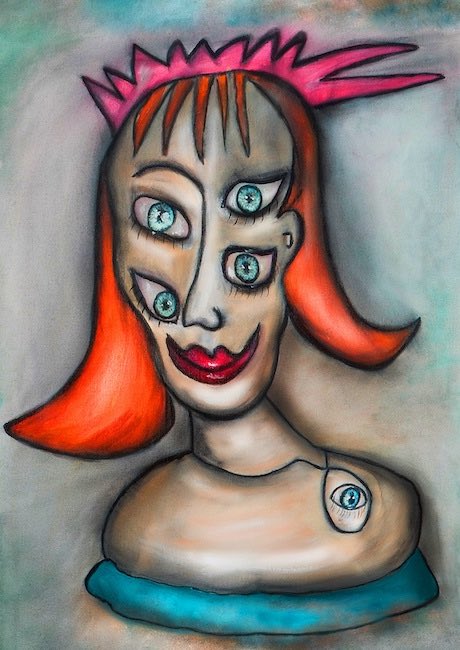
L’opera Unter fünf Augen (Sotto cinque occhi) è vicina alle distorsioni visive del Cubismo e all’irrealtà del Surrealismo poiché i cinque sguardi con cui la de Rablo caratterizza la donna protagonista sembrano sottolineare la poliedricità e l’apertura con cu affrontare la realtà ma anche gli accadimenti; d’altro canto per essere consapevoli di se stessi è altrettanto necessario affrontare e prendere atto di come gli altri ci vedono e dunque quei cinque occhi rappresentano la capacità dell’individuo di osservarsi dall’esterno per comprendere quali sono le reazioni suscitate ma decidendo comunque di andare avanti per la propria strada, mantenendo la propria bizzarria perché è attraverso di essa che si svela la vera personalità.
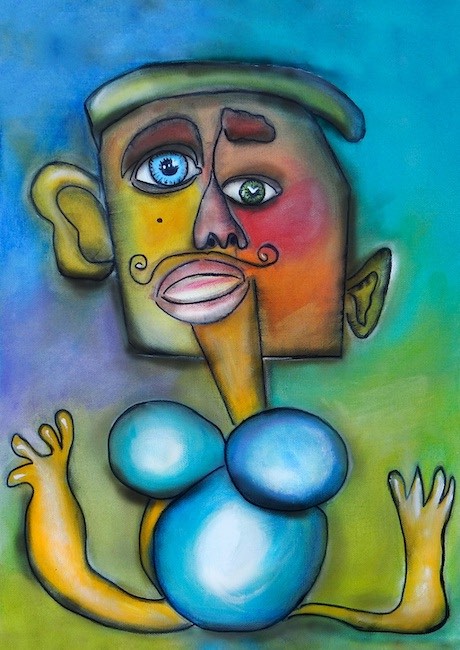
Anche la tela Pedanterie des starken Geschelecht (Pedanteria del sesso forte) si aggancia più delle altre alle deformazioni cubiste nella geometricità utilizzata per descrivere il volto e il corpo del personaggio che sembra sorpreso e costernato dalla sua stessa stranezza, dal suo essere poliedrico e molteplice nella sua essenza, sostenuto da quel trasformismo forse accresciuto dall’indefinitezza del genere di appartenenza; non si comprende infatti se sia uomo o donna o forse entrambi perché nel mondo di Ditha de Rablo la diversità è un valore, un aspetto da rendere protagonista per dar voce alle minoranze che non per questo devono essere lasciate ai margini.
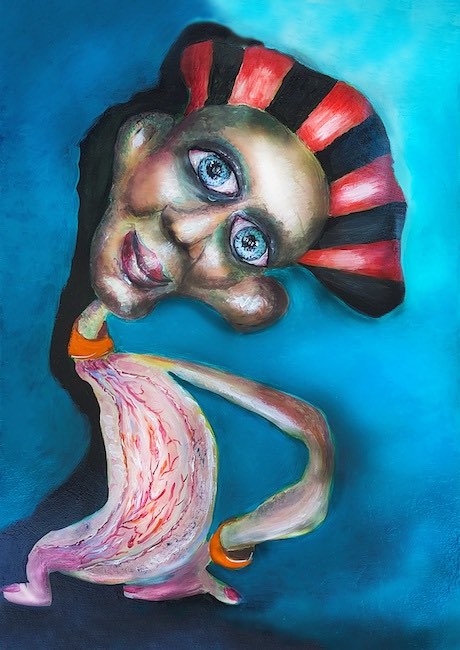
Nell’opera Geizhals (Tirchio) l’artista evidenzia l’atteggiamento allegro del personaggio che evidenzia con orgoglio un approccio alla vita spesso osteggiato per la tendenza a centellinare ogni spesa e ogni azione; la tendenza dell’essere umano di nascondere all’esterno quel modo di essere decade dunque perché il protagonista vive la sua condizione con simpatica rassegnazione, come se la consapevolezza gli conferisse uno sguardo scanzonato e al tempo stesso colpevole in senso giocoso, perché in fondo sa che la sua natura è quella e non sarebbe giusto cercare di modificarla. Dunque la persona di cui racconta la de Rablo appare serena perché ha accettato quella debolezza, ne ha preso atto e non la trattiene, sceglie di lasciarla fuoriuscire con naturalezza a dispetto della disapprovazione che può suscitare in chi gli sta intorno.
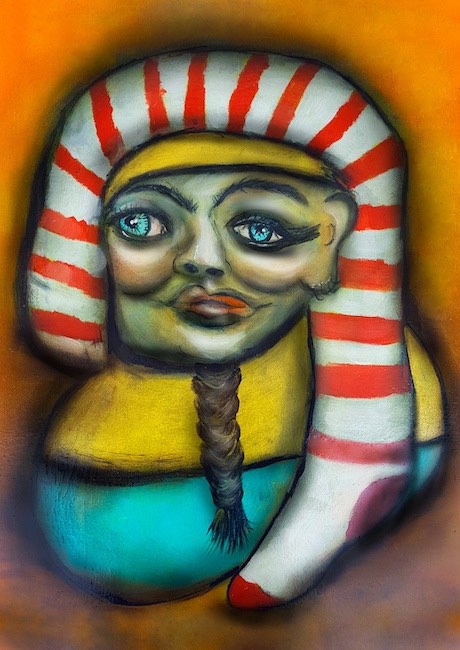
Sono caricature, enfatizzazioni della realtà i personaggi narrati, che lasciano sempre emergere lo sguardo sorridente dell’artista, una capacità di ironizzare sui piccoli difetti che inevitabilmente appartengono a chiunque, anche nell’individuo più perfezionista, l’attitudine a osservare tutto da un punto di vista positivo, persino nell’opera Aufgang der Arroganz (Aumento dell’arroganza).
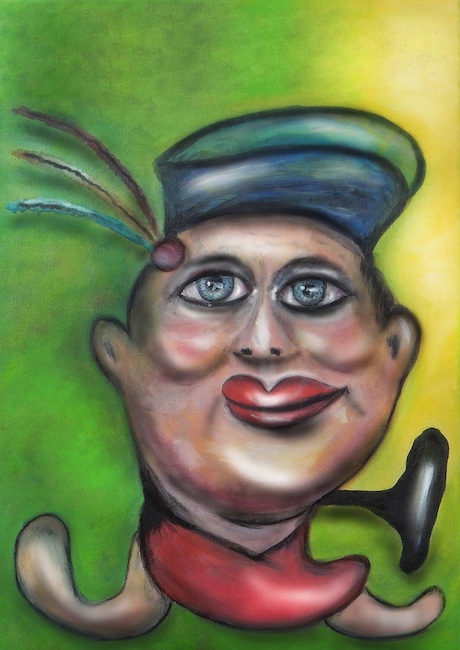
Qui il volto dell’uomo non ha un’espressione superba, tutt’altro, sembra invece a suo agio nella propria pelle, soddisfatto di sé in un modo che non può che attrarre la simpatia dell’osservatore il quale non si sente distante, allontanato da un atteggiamento spesso antipatico, piuttosto è indotto a sorridere da quella che, in virtù dell’approccio pittorico empatico della de Rablo, appare più come una debolezza che non un difetto. Accettazione dei propri limiti, autoironia, consapevolezza della propria eccentricità sono i segni distintivi ed essenziali della ricerca pittorica, ma anche sociologica, dell’artista che fa della stravaganza e dell’anticonformismo non solo un valore aggiunto dal punto di vista umano ma anche la base di uno stile pittorico unico. Ditha de Rablo ha esposto le sue opere, riscuotendo successi e premi, in Italia, a New York, al Museo Meom di Barcellona e ha preso parte alla mostra di Yoko Ono Peace is power al Museo di Lipsia.
DITHA DE RABLO-CONTATTI
Email: info@rabio.email
Sito web: https://www.saatchiart.com/account/artworks/1284461
Facebook: https://www.facebook.com/iudita.rabl
Linkedin: https://www.linkedin.com/in/ditha-de-rablo-2b4949172/
Instagram: https://www.instagram.com/ditha_de_rablo/
Distorted faces and bizarre characters in Ditha de Rablo’s Gagaism, an exhortation not to be afraid to be oneself
The theme of the expression of one’s being, one’s interiority or approach to existence is something that many contemporary artists often deal with, tending to let out all that emotional world that outside of the canvas or sculptural material they would not be able to manifest; this is because the raw surface appears as a window for dialogue with oneself, a way to explore those intimate sensations that only in the creative act find their voice. The expressive style thus simply becomes a medium akin to the personality of the performer of the artwork, sometimes more impulsive, sometimes more rational, and sometimes more intimate. In the case of today’s protagonist, on the other hand, the pictorial approach is the means of narrating that strangeness which belongs to each individual but that human beings are hardly able to accept and admit, even to themselves.
The discovery of the need to liberate all that inner world that until recently had been left in the background compared to perfection and aesthetic balance, came over the art world at the end of the 19th century in a strong manner, almost overbearing in its impellence, as if the dams of academic rules could no longer hold back the desire to break through the expressive boundaries; the theories of the Fauves, who never constituted a true pictorial movement other than a union to pursue the common goal of laying the foundations for an unprecedented way of making art, subverted every rule, destabilised everything that was acquired in terms of the patterns of execution of a work of art. Chiaroscuro, perspective, relevance to the observed reality, realistic colours, everything was cancelled out by the sole imperative to show in an immediate and impetuous way the inner drives, to interpret everything that was caught by the gaze in a subjective way and in that way bring it to the canvas. The subsequent evolution brought about by Expressionism, which, depending on the artist or the country of origin, took on different characteristics, especially from the point of view of description and colour range, highlighted another characteristic that was functional to the movement’s unavoidable aim, that of abandoning the link with beauty, with the harmony of forms, if not akin to the sensations one wished to imprint on the canvas; the grotesque deformations of James Ensor and Oskar Kokoschka, whose characters were allegories of the superficiality or dissolution of the values of their era, the dark and anguished atmospheres of Edvard Munch, the obsession with nudity as the only way to survive the atrocities of war and to emphasise an attachment to life by Egon Schiele, were in essence different approaches to expressing one’s emotions, certainly, but also to exploring the world around one, which did not have to be beautiful to arouse emotions.
The theme of the lack of aesthetic balance functional to know and accept fears, anxieties and inner fragilities was taken up years later by one of the greatest representatives of the London School, Lucian Freud, who revealed to the world the beauty in imperfection, the fascination of the insecurity of those who do not correspond to the traditional canons of exterior harmony but who, perhaps because of this, are able to cure and deepen other aspects. The Romanian-born but naturalised German artist Ditha de Rablo follows a path in which the acceptance and awareness of diversity, of the bizarre, are fundamental and unavoidable elements for her personal style of painting that can be defined as Gagaism, precisely because the characters she describes are unconventional, not afraid of judgement, not timorous to show themselves in their strangeness because they have accepted it as part of themselves, as an essence to be proud of. De Rablo’s life path has led her to fight to assert her own personality that does not conform to what the environment in which she grew up would have required, and as a result of her choice to pursue her freedom she has had to face obstacles and difficulties, falls from which she has then risen with the awareness that every event brings with it a positive side as long as people are able to remain true to themselves, to their true nature.
Thus, her pictorial journey has been a way of constantly emphasising her pride in belonging to that people of the bizarre, the out-of-chorus, the eccentrics called Gaga, represented for a long time by the famous singer Lady Gaga, who are not afraid to reveal their purest essence, which does not need approval from the outside because what counts is self-acceptance. Ditha de Rablo takes her cue from the unreal colour palette of Expressionism, as she takes its characteristic of outlining her characters with a well-defined border in contrast to the dominant colours with which they are portrayed, which she then skilfully mixes with the unreality of Surrealism and the decomposition of Cubism, though not taking the geometricity from the latter but rather the multiple and contemporary point of view on the observed. The artwork Unter fünf Augen (Under five eyes) is close to the visual distortions of Cubism and the unreality of Surrealism, as the five gazes with which de Rablo characterises the female protagonist seem to emphasise the multifacetedness and openness with which she confronts reality as well as events; on the other hand, in order to be aware of oneself, it is equally necessary to face and take note of how others see us and therefore those five eyes represent the individual’s ability to observe himself from the outside in order to understand what reactions are aroused but still deciding to go on his own way, maintaining his eccentricity because it is through it that the true personality is revealed.
The canvas Pedanterie des starken Geschelecht (Pedantry of the stronger sex) also latches on more than the others to Cubist deformations in the geometricity used to describe the face and body of the character who seems surprised and dismayed by his own strangeness, by his being multifaceted and multiple in his essence, sustained by that transformism perhaps heightened by the indefiniteness of his gender; in fact, it is not clear whether he is a man or a woman, or perhaps both, because in Ditha de Rablo’s world, diversity is a value, an aspect to be made a protagonist in order to give a voice to minorities who should not be left on the margins. In the artwork Geizhals (Stingy), the artist highlights the cheerful attitude of the character who proudly shows an approach to life that is often opposed due to the tendency to cut down on every expense and every action; the tendency of human beings to hide that way of being from the outside decays, therefore, because the protagonist lives his condition with sympathetic resignation, as if awareness gives him a light-hearted look and at the same time a playful guiltiness, because deep down he knows that that is his nature and it would not be right to try to change it. So the person de Rablo is talking about appears serene because he has accepted that weakness, he has taken note of it and does not hold it back, he chooses to let it out naturally in spite of the disapproval it may arouse in those around him. The characters narrated are caricatures, emphasisations of reality, which always allow the artist’s smiling gaze to emerge, an ability to ironise the small faults that inevitably belong to everyone, even in the most perfectionist individual, the ability to observe everything from a positive point of view, even in the painting Aufgang der Arroganz (Increase in Arrogance). Here, the man’s face does not have a haughty expression, far from it, instead he seems comfortable in his own skin, self-satisfied in a way that cannot but attract the sympathy of the observer who does not feel distant, removed by an often unpleasant attitude, but rather is induced to smile by what, by virtue of de Rablo’s empathetic pictorial approach, appears more like a weakness than a defect. Acceptance of one’s limits, self-mockery, and awareness of one’s own eccentricity are the distinctive and essential signs of the pictorial, but also sociological, research of the artist, who makes extravagance and non-conformity not only an added value from a human point of view, but also the basis of a unique painting style. Ditha de Rablo has exhibited her works, gaining success and awards, in Italy, in New York, at the Meom Museum in Barcelona and took part in Yoko Ono’s exhibition Peace is power at the Leipzig Museum.


